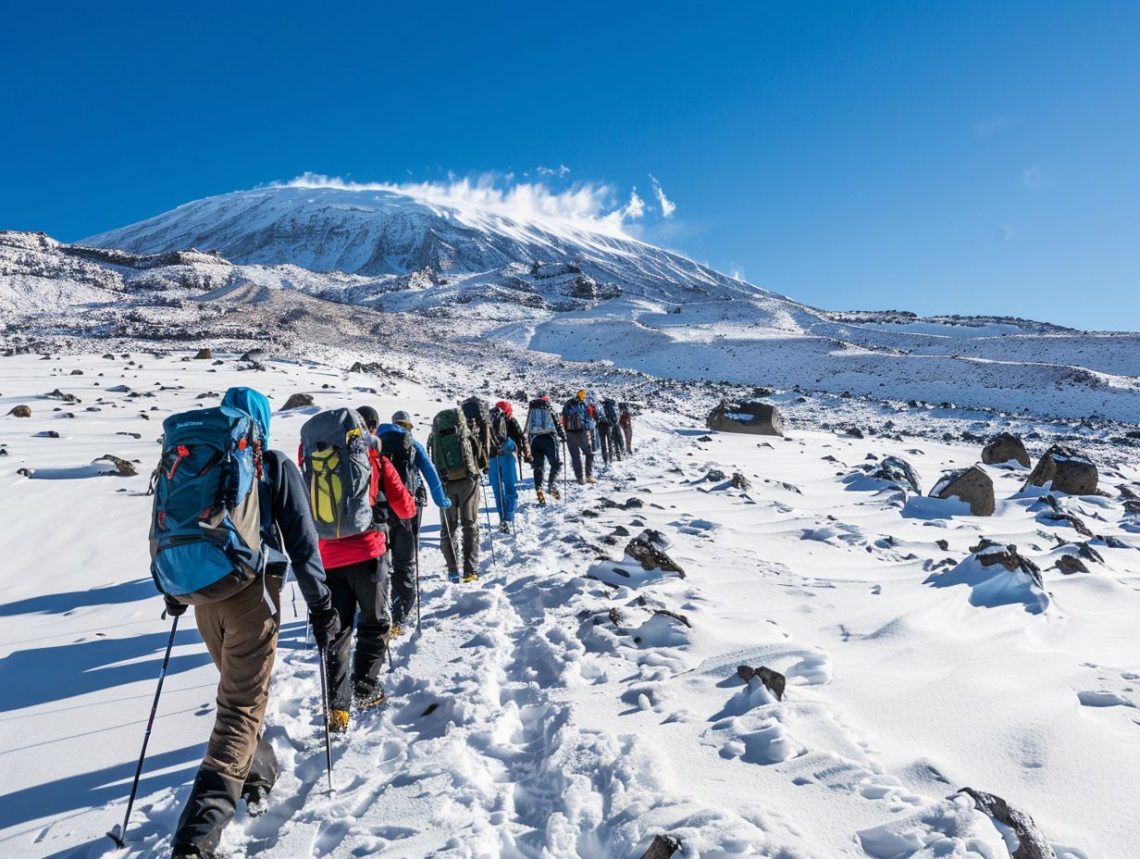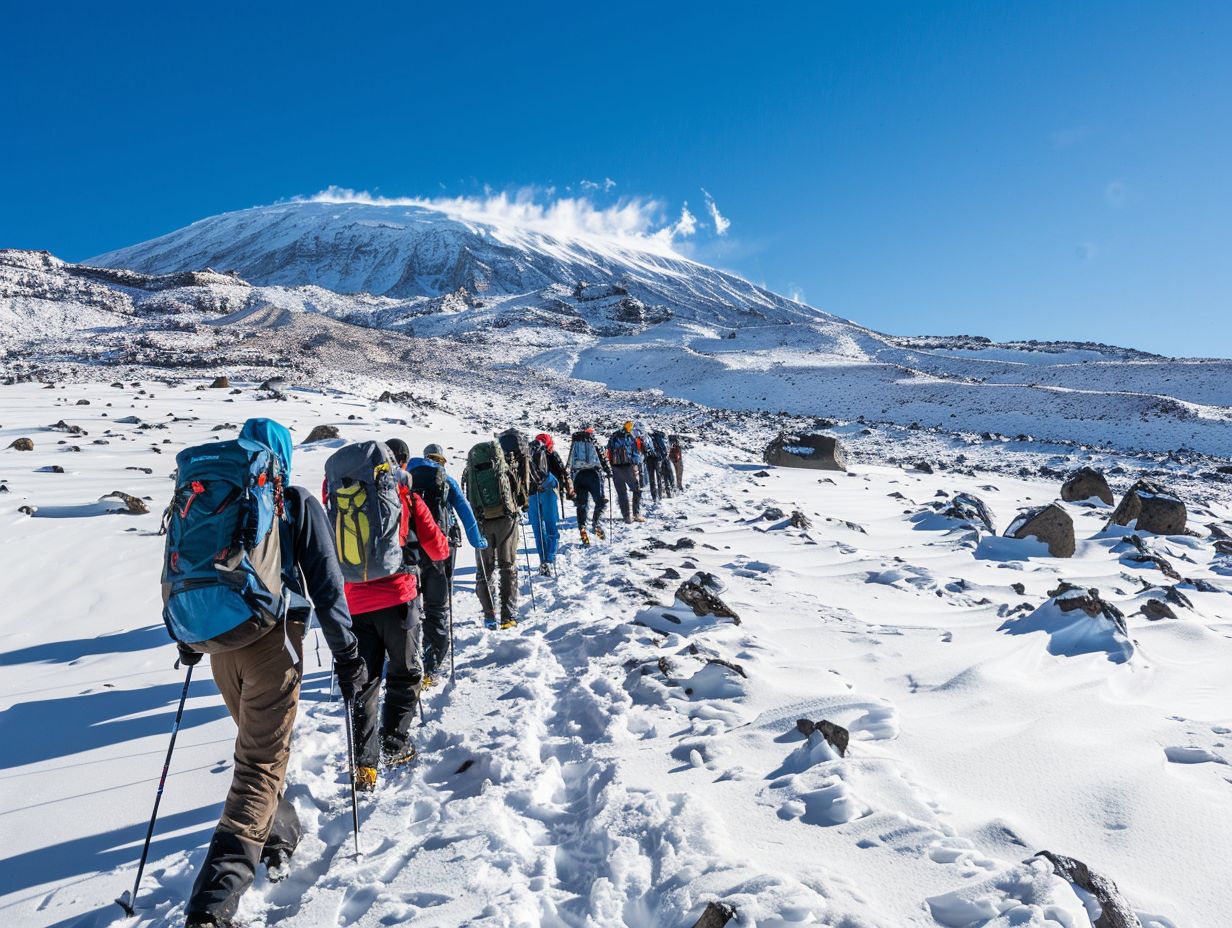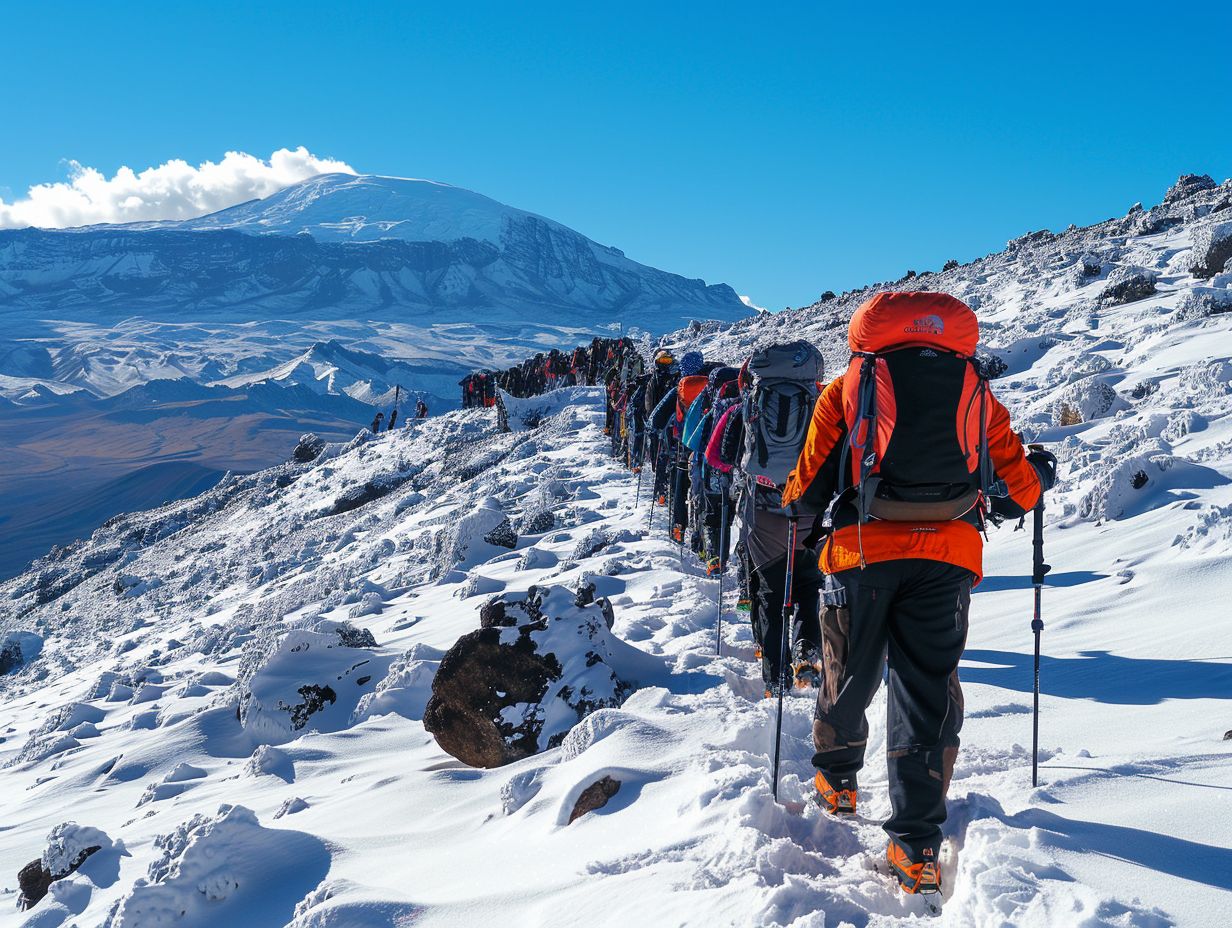
Climbing Kilimanjaro In September
Are you considering climbing Kilimanjaro in September but not sure if it’s the right time for you?
Discover why September is a great month for this adventure. From favorable weather conditions to fewer crowds and lower prices, September offers a unique experience for climbers.
Learn about the different routes available, physical requirements, essential gear, safety precautions, tips for success, possible challenges, and must-see attractions along the way.
Find out if climbing Kilimanjaro in September is worth it!
Key Takeaways:

- Climbing Kilimanjaro in September offers favorable weather conditions, fewer crowds, and lower prices.
- There are five different routes to choose from for climbing Kilimanjaro in September, including the popular Machame and Lemosho routes.
- While physical fitness is important, proper gear and equipment, safety precautions, and tips for a successful climb are also essential for a September climb on Kilimanjaro.
What is the Best Time to Climb Kilimanjaro?
The best time to climb Kilimanjaro largely depends on the weather conditions and the experience you seek. Understanding the distinct seasons on the mountain is crucial for planning a successful ascent.
Mount Kilimanjaro, Africa’s highest peak, experiences two main seasons – the dry season and the rainy season.
Dry months like January to March and July to October are popular among climbers for clear skies, low precipitation, and excellent visibility. Stable weather conditions make trekking easier without heavy rainfall or slippery trails.
The rainy season, from April to June and November to December, brings challenges like slippery paths, reduced visibility, and higher risks of avalanches and rockfalls.
Climbing during this time demands extra caution due to wet conditions and potential hazards.
The summit region can experience freezing temperatures, especially at night, so it’s essential for climbers to be equipped with appropriate cold-weather gear.
Safety considerations should always be a top priority, regardless of the chosen climbing month.
Why Choose September for Climbing Kilimanjaro?
September stands out as an excellent month for climbing Kilimanjaro due to favorable weather conditions, fewer crowds, and the allure of summiting under the enchanting glow of a full moon.
1. Favorable Weather Conditions
In September, Kilimanjaro experiences stable weather conditions with clear skies and dry months, providing ideal trekking conditions for climbers to navigate through the diverse climate zones.
These stable weather patterns in September on Kilimanjaro are crucial for climbers as they reduce the chances of sudden weather changes and enhance visibility on the trekking routes.
The impact of different climate zones, from the lush rainforest to the arid alpine desert, offers a unique experience for climbers in terms of flora and fauna diversity.
Understanding the distinctions between dry and wet months is vital for climbers planning their Kilimanjaro adventure.
Dry months like September typically offer less precipitation, making trekking conditions more favorable and increasing the chances of successful summit attempts.
On the other hand, wet months bring about challenges such as slippery trails, reduced visibility, and higher risks of hypothermia, affecting the overall trekking experience and safety of climbers.
2. Fewer Crowds
September offers the advantage of fewer crowds on the mountain, allowing climbers to enjoy a more serene and intimate experience while trekking up Kilimanjaro.
With less foot traffic on the trails, climbers in September have the opportunity to immerse themselves in the pristine beauty of the surroundings, undisturbed by the hustle and bustle typical of peak seasons.
Reduced crowds mean more space to appreciate the natural wonders of Kilimanjaro, from the diverse flora to breathtaking viewpoints along the way.
For experienced trekkers, the quieter trails present a chance to delve deeper into the challenge of the ascent, focusing on personal growth and conquering new heights.
New hikers, on the other hand, can benefit from a more gradual introduction to high-altitude trekking, building confidence at a comfortable pace.
With fewer people around, trekkers often form tight-knit bonds, sharing stories, encouragement, and a mutual appreciation for the magnificent journey they are undertaking together.
3. Lower Prices
In September, climbers can find discounted Kilimanjaro expeditions with lower prices, accommodation deals, and cost-effective group climbs, often including private toilet facilities.
By opting for group climbs in September, climbers not only save on costs but also enjoy the camaraderie and support of fellow trekkers on the journey.
Many tour operators offer special discounts or incentives for booking during this month, making it an attractive choice for budget-conscious adventurers.
Choosing cost-efficient accommodation options, such as camping or staying in shared huts, can further reduce expenses without compromising on comfort.
What Are the Different Routes for Climbing Kilimanjaro in September?

September opens up a variety of route options for climbers tackling Kilimanjaro, each offering unique perspectives of the mountain and diverse trekking experiences.
1. Marangu Route
The Marangu Route in September offers climbers a classic trek up Kilimanjaro, passing through lush rainforests, past glaciers, and culminating at the summit peak of Uhuru Peak.
September climbers embarking on the Marangu Route are treated to a magical journey that begins in the vibrant greenery of the rainforests, where the symphony of exotic bird calls and lush flora creates an enchanting atmosphere.
As they ascend higher, the landscape transforms, offering breathtaking views of ancient glaciers glistening in the sun.
This trail, known for its gradual slopes and well-established huts, provides a more comfortable ascent for adventurers seeking a unique mountain experience.
The allure of the Marangu Route lies not only in its scenic beauty but also in the challenge it presents, testing the endurance and determination of those who dare to conquer its heights.
2. Machame Route
September explorers on the Machame Route are treated to a challenging ascent, traversing snowy paths and rugged trails that lead them closer to the summit of Kilimanjaro.
September is a prime time for adventurers looking to test their limits on the Machame Route. As they navigate through the snow-covered sections and rocky terrains, the breathtaking scenery of the trail unfolds before them.
The high-altitude trekking conditions provide a unique experience, where each step taken brings them closer to the iconic peak.
- The demanding terrain requires climbers to be prepared physically and mentally for the journey ahead.
- Guided by experienced leaders, trekkers can feel a sense of security and confidence as they push through the challenging route.
- Conquering the Machame Route in September is not just about reaching the summit; it’s about embracing the raw beauty of nature and the sense of accomplishment that comes with it.
3. Lemosho Route
September adventurers embarking on the Lemosho Route are rewarded with stunning vistas of Tanzania’s landscapes as they journey closer to the equator and higher altitudes on their Kilimanjaro expedition.
The Lemosho Route, known for its scenic beauty, offers a diverse range of environments, from lush rainforests to alpine deserts, providing a truly immersive experience for trekkers.
As climbers ascend through various ecological zones, they witness a dramatic transformation in vegetation and climate, with each level revealing unique flora and fauna endemic to the region.
The proximity to the equator results in a rich tapestry of biodiversity that captivates the senses, making the journey not only challenging but also visually rewarding.
4. Rongai Route
The Rongai Route in September offers climbers a unique trekking experience, including a thrilling summit night ascent, encounters with glaciers, and the euphoria of reaching the summit of Uhuru Peak.
During September, the Rongai Route showcases its charm with clear skies and crisp air, providing ideal conditions for climbers to embark on their adventure.
The summit night ascent on this route is particularly exhilarating, with the dark sky sparkling with bright stars, creating a magical atmosphere as climbers make their way towards the peak.
Encounters with glaciers along the trail add a sense of awe-inspiring beauty, with the glistening ice formations reflecting the sunlight in mesmerizing patterns.
As climbers finally conquer Uhuru Peak, the highest point of Mount Kilimanjaro, a profound sense of accomplishment washes over them, marking the culmination of their journey and creating memories to last a lifetime.
5. Northern Circuit Route
September thrill-seekers opt for the Northern Circuit Route for an exhilarating moonlight trek, equipped with summit gear and a spirit of adventure that defines the unique experience of climbing Kilimanjaro.
Guided by the luminous glow of the full moon, climbers navigate the rugged terrain amidst an ethereal ambiance, showcasing nature’s splendor in a mystical light.
The ascent is not only about physical endurance but also a spiritual journey, with each step resonating a sense of accomplishment and introspection.
Ensuring proper summit gear such as layers for varying temperatures, sturdy boots, headlamp, and hydration packs are essential for seamless progress under the moon’s benevolent gaze.
The Northern Circuit Route beckons adventurers to embrace the unknown, revel in the unpredictability, and bask in the serenity of the mountains.
What Are the Physical Requirements for Climbing Kilimanjaro in September?

Climbing Kilimanjaro in September demands adequate physical preparation, efficient time management, and the ability to acclimatize to varying altitudes and weather conditions for a successful trekking experience.
To conquer the challenges of high-altitude trekking, strong stamina and endurance are crucial for tackling steep terrain and long hours of hiking.
- Acclimatization strategies play a vital role in preventing altitude sickness, allowing climbers to adapt gradually to the decreasing oxygen levels.
- Time management is key when climbing Kilimanjaro; setting a steady pace, taking regular breaks, and staying hydrated are crucial elements to navigate through the diverse landscapes and environmental conditions.
- Weather variations can significantly impact the climb, with September typically experiencing colder temperatures and potential rain showers.
- Packing appropriate gear for changing weather conditions and being mentally prepared for unexpected challenges can greatly enhance the overall climbing experience.
What Are the Essential Gear and Equipment for Climbing Kilimanjaro in September?
When preparing for a September climb on Kilimanjaro, essential gear like summit gear, head torches, and weather-appropriate equipment are crucial for ensuring safety and comfort during the trek.
Summit gear such as high-quality and durable hiking boots, trekking poles, and insulated clothing are fundamental for coping with the challenging terrains and low temperatures encountered while ascending Kilimanjaro.
Head torches become critical for night treks, providing necessary illumination along the paths.
Climbers should invest in specialized equipment like altitude sickness medication, crampons, and ice axes to navigate the diverse weather conditions at different altitudes on the mountain.
Adapting to the unique demands of full moon climbs requires extra precautions, including warmer layers and increased visibility tools to ensure a safe and successful journey to the summit.
What Are the Safety Precautions for Climbing Kilimanjaro in September?
Safety is paramount on a September Kilimanjaro climb. Adhere to safety precautions, monitor weather, and follow experienced guides to mitigate altitude and weather risks.
September climbers on Kilimanjaro must be prepared for the unpredictable mountain weather. It’s crucial to have proper gear for both cold and warm conditions and to stay informed about weather updates.
Adjusting to high altitudes requires acclimatization through a slow ascent pace and adequate hydration. Altitude sickness is a serious concern, so recognizing symptoms like headaches, nausea, and fatigue is imperative.
Relying on skilled guides with extensive knowledge of the mountain can provide invaluable support and increase the overall safety of the journey.
What Are the Tips for a Successful Climb in September?
For a successful Kilimanjaro climb in September, prioritize physical conditioning, consider weather’s impact, and follow expert climbing advice for a triumphant ascent.
Physical training is vital to prepare your body for the demands of high-altitude trekking. Include cardio exercises, strength training, and hikes with elevation gain to build endurance and muscle strength.
Being weather-aware during your trek is crucial. September on Kilimanjaro can bring unpredictable conditions, so pack appropriate clothing layers, consider hydration needs, and be mindful of potential altitude-related challenges.
Implementing climbing tips from experienced mountaineers can improve your performance and safety on the mountain. Techniques such as pacing yourself, proper gear usage, and acclimatization strategies go a long way.
What Are the Possible Challenges of Climbing Kilimanjaro in September?
Climbing Kilimanjaro in September brings challenges like unpredictable weather, precipitation, and altitude hurdles. Climbers must navigate cautiously for a safe ascent.
One of the primary concerns faced by climbers during this time is the sudden changes in weather patterns, which can range from intense heat to chilling cold within a short span, demanding the need for layered clothing and thermal protection gear.
The fluctuating precipitation levels pose a significant obstacle, making the terrain slippery and increasing the risk of accidents.
The physiological strain of ascending to high altitudes brings about the potential for altitude sickness, requiring acclimatization periods and careful monitoring of one’s health throughout the climb.
What Are the Must-See Attractions on the Way to the Summit in September?
The journey to the summit of Kilimanjaro in September is adorned with captivating attractions like breathtaking mountain views, enchanting full moon climbs, and an adventurous trekking experience.
Beginning the trek along the Lemosho route, trekkers are treated to a panorama of lush rainforest teeming with diverse flora and fauna. As the journey progresses, the landscape transitions into alpine desert.
As the night falls, the magic of full moon climbs comes alive, casting a mystical glow over the rugged terrain and illuminating the path ahead. The silvery light dancing on the rocks creates an ethereal atmosphere.
The adventurous spirit of the trek is palpable as climbers navigate through challenging terrains, conquering steep ascents and rocky trails with determination and perseverance.
Each twist and turn on the path reveals new vistas of unparalleled beauty, inspiring a sense of wonder and awe in every adventurer’s heart.
Conclusion

September Kilimanjaro climbs offer optimal weather, enchanting full moon ascents, and transformative experiences for adventure seekers. Mild daytime temperatures and cooler nights create comfortable trekking conditions.
Ascending under the full moon adds mystique to the journey’s beauty. Adventure enthusiasts are drawn to September expeditions for diverse landscapes and the thrill of summiting Africa’s highest peak.
Climbing Kilimanjaro in September isn’t just about physical achievement; it’s a holistic journey of nature immersion and personal growth, creating lasting memories.
Frequently Asked Questions
1. Is September a good time to climb Kilimanjaro?
A: Yes, September is considered one of the best months to climb Kilimanjaro. The weather is relatively mild and dry, making for ideal climbing conditions.
2. What is the weather like in September on Kilimanjaro?
A: The weather on Kilimanjaro in September is generally dry and mild, with average temperatures ranging from 41-68°F (5-20°C) and minimal rainfall. However, it is important to note that weather conditions can change quickly on the mountain, so it is best to be prepared for all types of weather.
3. How long does it take to climb Kilimanjaro in September?
A: The duration of the climb varies depending on the route chosen, but on average it takes 6-7 days to reach the summit of Kilimanjaro in September. This allows for proper acclimatization and a more enjoyable climb.
4. What is the success rate for climbing Kilimanjaro in September?
A: The success rate for climbing Kilimanjaro in September is around 70-80%. This is due to the favorable weather conditions and the gradual ascent up the mountain, allowing for proper acclimatization.
5. Are there any special preparations needed for climbing Kilimanjaro in September?
A: It is recommended to have a good level of physical fitness and to train specifically for the climb. It is also important to have proper gear and clothing for varying weather conditions. Additionally, obtaining the necessary permits and arranging transportation and accommodation in advance are important preparations to make.
6. Is it possible to see wildlife while climbing Kilimanjaro in September?
A: Yes, there is a chance to see some wildlife while climbing Kilimanjaro in September. The mountain is located within a national park, and there are various routes that offer opportunities to spot animals such as monkeys, antelopes, and birds along the way.